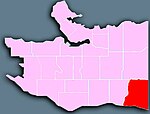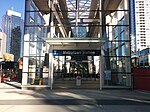CJVB

CJVB (1470 kHz) is a radio station in Vancouver, British Columbia, Canada, which broadcasts multilingual programming. Owned by the Fairchild Group, the station with a power of 50,000 watts, using two different directional patterns for daytime and nighttime operation. CJVB's studios and transmitter are located in Richmond. Operation began as a 10,000-watt station at the same transmitter site in 1972, with a power increase to 50 kW in 1979. The station was originally licensed to Jan van Bruchem, whose initials give CJVB its call letters. CJVB was the third multicultural radio station in Canada, following CHIN in Toronto and CFMB in Montreal. It was also the first radio station in the Vancouver area to broadcast in AM stereo. CJVB airs primarily Chinese (Cantonese and Mandarin) programming from Monday through Saturday. On Sunday, the station airs a selection of programs in other languages.
Excerpt from the Wikipedia article CJVB (License: CC BY-SA 3.0, Authors, Images).CJVB
Number 8 Road, Richmond
Geographical coordinates (GPS) Address Nearby Places Show on map
Geographical coordinates (GPS)
| Latitude | Longitude |
|---|---|
| N 49.192944444444 ° | E -123.02241666667 ° |
Address
Number 8 Road
V5S 0C2 Richmond (East Richmond)
British Columbia, Canada
Open on Google Maps






